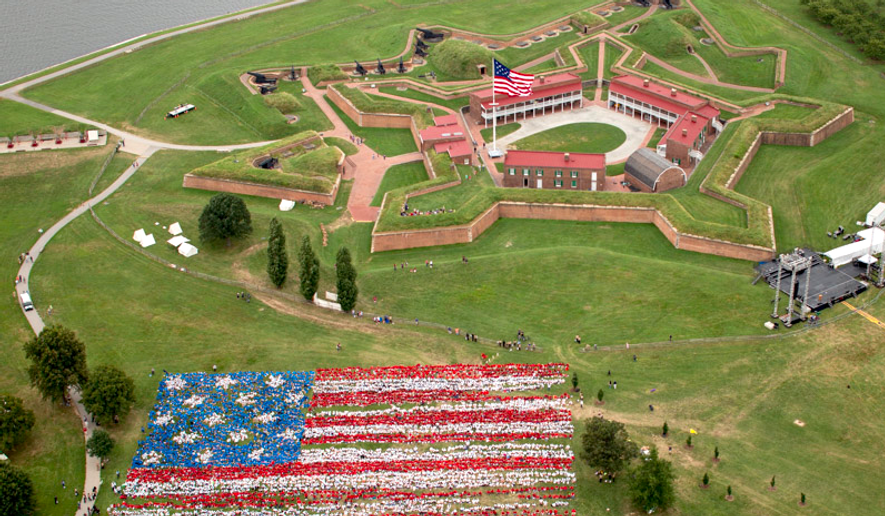The “Banner” is marking a big birthday this weekend.
It was 200 years ago Sunday that the battle of Baltimore Harbor inspired Francis Scott Key to write the words to “The Star-Spangled Banner,” but as the nation celebrates the 200th birthday of its national anthem, many are discovering that its history is richer than they thought.
President Obama, on his way to a Baltimore fundraiser, visited Fort McHenry on Friday, where he viewed the original lyrics penned by the author. Celebrations in Baltimore have been non-stop all week, including fireworks displays, historical reenactments and live performances.
One of the biggest and flashiest salutes to “The Star-Spangled Banner” comes Saturday at the University of Michigan, the Associated Press reported. The Ann Arbor school’s marching band, a 500-voice choir and dance team combine during a football halftime show to celebrate the anthem. The university held a massive sing-along Friday, the same day it opens an exhibit on the national anthem’s cultural history.
Most Americans know that the now-famous song started out as a poem that Key wrote after witnessing the young nation’s successful defense of Fort McHenry against the British in the final year of the War of 1812. Key, a prominent Washington lawyer, was an occasional versifier, not a composer. He was, in fact, tone-deaf.
“He was an amateur poet, but not just any poet — he was a bad amateur poet,” Virginia historian Marc Leepson wrote in his recent book “What So Proudly We Hailed.” Mr. Leepson said that Key’s own family charitably described him as “unmusical.”
PHOTOS: A celebration of 'The Star-Spangled Banner'
Key did not actually invent the phrase “Star-Spangled.” Although it was made famous by his poem, the phrase was first used by Shakespeare, according to historian Marc Ferris, author of “Star-Spangled Banner: The Unlikely Story of America’s National Anthem.”
However, Key did coin another famous phrase that would win immortality as the nation’s motto, to be found on U.S. currency. According to Mr. Ferris, “In God We Trust” stems from a line in the fourth verse of Key’s poem, “Then conquer we must, when our cause it is just/ And this be our motto: In God is our trust.”
Bits and pieces of the giant flag that flew over Fort McHenry have been missing since the 1880s. After the historic victory, clippings of the flag were given away as keepsakes.
Jennifer Jones, a curator at the Smithsonian’s National Museum of American History, where the flag is housed, told the Associated Press,”It was such a monumental moment in time that people felt they wanted to hold a piece of that history.”
Park rangers at Fort McHenry said visits to the park have increased by 30 percent since 2012. On a yearly basis, they expect 600,000 visitors, but with the bicentennial, they have seen about 800,000.
Not all come with a firm grasp of the unlikely story of how the anthem came to be.
SEE ALSO: Obama tours Ft. McHenry, views original lyrics of ‘Star-Spangled Banner’
Many need to be filled in on the details, Fort McHenry Park Ranger Paul Plamann told The Washington Times in a profile this summer.
“Some people don’t even place ’The Star-Spangled Banner’ in that time period,” he said. “They think it may be [from the] Revolutionary War or perhaps the Civil War.”
Mr. Plamann, who has been a ranger at Fort McHenry for 47 years, said he is happy to fill in the details in talks with visitors.
In a program called “Broad Stripes and Bright Stars,” Mr. Plamann draws a crowd together to open a full-sized flag. As toddlers, teenagers and adults grip the flag, he recounts the history of the flag and its maker, Mary Pickersgill, who made two flags for the fort.
“Now don’t get Mary mixed up with that gal in Philadelphia,” he said. “Betsy, she’s working on banners up there.”
In 1948, President Truman ordered Fort McHenry to fly the flag around the clock as a “perpetual symbol of our patriotism.”
It’s something that Ms. White said they are proud to do, in part in response to the famous question that ends the first stanza of Key’s poem.
“We’re answering that question he asks,” she said. “Today, yes the flag still waves over Fort McHenry.”
The visitors center includes a museum that gives a look into the events leading up to the War of 1812 and the British’s Chesapeake campaign. At the end of the re-enactment video, the national anthem is played and the video screen rises to unveil the flag over the fort, placing you in the shoes of Key himself after the battle.
Walking through the star-shaped fort that guarded the entrance to Baltimore, visitors can explore the fort’s bomb shelters, sit in bunk beds from the 1800s and imagine soldiers in small Civil War jail cells. In an ironic twist, Key’s grandson was detained there in 1861 for being a Confederate sympathizer.
Writing from his cell, Frank Key Howard said, “I could not but contrast my position with his, 47 years before. The flag which he had then so proudly hailed, I saw waving, at the same place, over the victims of as vulgar and brutal a despotism as modern times have witnessed.”
• Meghan Drake contributed to this story, which was based in part on wire service reports.
• Kellan Howell can be reached at khowell@washingtontimes.com.




Please read our comment policy before commenting.